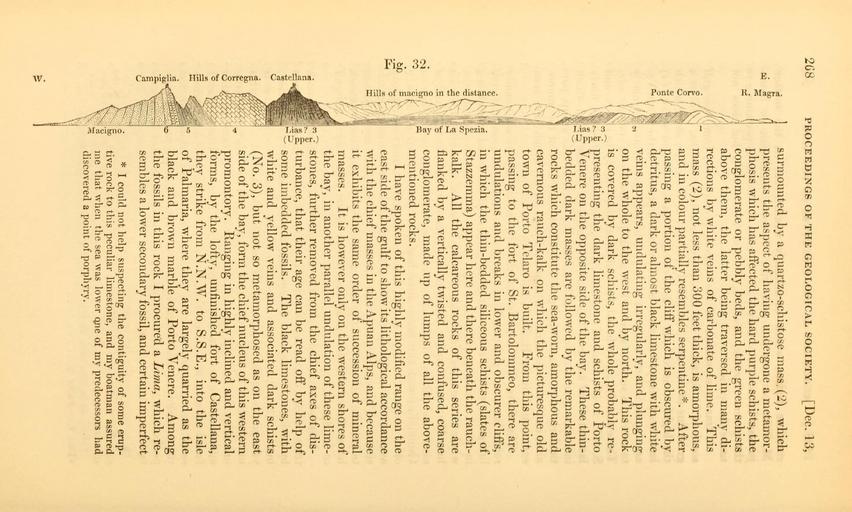MAKE A MEME
View Large Image

| View Original: | The_Quarterly_journal_of_the_Geological_Society_of_London_(12645167315).jpg (1984x1192) | |||
| Download: | Original | Medium | Small | Thumb |
| Courtesy of: | commons.wikimedia.org | More Like This | ||
| Keywords: The Quarterly journal of the Geological Society of London (12645167315).jpg 268 <br> PROCEEDINGS OF THE GEOLOGICAL SOCIETY DeC 13 <br> it <br> \ <br> i' <br> g <br> surmounted by a quartzo-scliistose mass 2 which <br> presents the aspect of havhig undergone a metamor- <br> phosis which has affected the hard purple schists the <br> conglomerate or pebbly beds and the green schists <br> above them the latter being traversed in many di- <br> rections by white veins of carbonate of hme This <br> mass 2 not less than 300 feet thick is amorphous <br> and in colour partially resembles serpentine After <br> passing a portion of the cliff which is obscured by <br> detritus a dark or almost black limestone with white <br> veins appears undulating irregularly and plunging <br> on the whole to the west and by north This rock <br> is covered by dark schists the Avhole probably re- <br> presenting the dark limestone and schists of Porto <br> Venere on the opposite side of the bay These thin- <br> bedded dark masses are followed by the remarkable <br> rocks which constitute the sea-worn amorphous and <br> cavernous rauch-kalk on which the picturesque old <br> town of Porto Telaro is built From this point <br> passing to the fort of St Bartolommeo there are <br> undulations and breaks in lower and obscurer cliffs <br> in which the thin-bedded siliceous schists slates of <br> Stazzemma appear here and there beneath the rauch- <br> kalk All the calcareous rocks of this series are <br> flanked by a vertically twisted and confused coarse <br> conglomerate made up of lumps of all the above- <br> mentioned rocks <br> I have spoken of this highly modified range on the <br> east side of the gulf to show its lithological accordance <br> with the chief masses in the Apuan Alps and because <br> it exhibits the same order of succession of mineral <br> masses It is however only on the western shores of <br> the bay in another parallel undulation of these lime- <br> stones further removed from the chief axes of dis- <br> turbance that their age can be read off by help of <br> some imbedded fossils The black limestones with <br> white and yellow veins and associated dark schists <br> No 3 but not so metamorphosed as on the east <br> side of the bay form the chief nucleus of this western <br> promontory Ranging in highly inclined and vertical <br> forms by the lofty unfinished fort of Castellana <br> they strike from N N AY to S S E into the isle <br> of Palmaria where they are largely quarried as the <br> black and brown marble of Porto Yenere Among <br> the fossils in this rock I procured a Lima which re- <br> sembles a lower secondary fossil and certain imperfect <br> I could not help suspecting the contiguity of some erup- <br> tive rock to this pecuhar limestone and my boatman assured <br> me that \Yhen the sea was lower cuie of my predecessors had <br> discovered a pohit of porphyry <br> 35268912 109512 51125 Page 268 Text v 5 http //www biodiversitylibrary org/page/35268912 1849 Geological Society of London NameFound Castellana NameConfirmed Castellana NameBankID 4489396 NameFound Palmaria NameConfirmed Palmaria EOLID 89986 NameBankID 439060 Biodiversity Heritage Library The Quarterly journal of the Geological Society of London v 5 1849 Geology Periodicals Smithsonian Libraries bhl page 35268912 dc identifier http //biodiversitylibrary org/page/35268912 smithsonian libraries Information field Flickr posted date ISOdate 2014-02-20 Check categories 2015 August 26 CC-BY-2 0 BioDivLibrary https //flickr com/photos/61021753 N02/12645167315 2015-08-27 10 58 50 cc-by-2 0 PD-old-70-1923 The Quarterly journal of the Geological Society of London 1849 Photos uploaded from Flickr by Fæ using a script | ||||